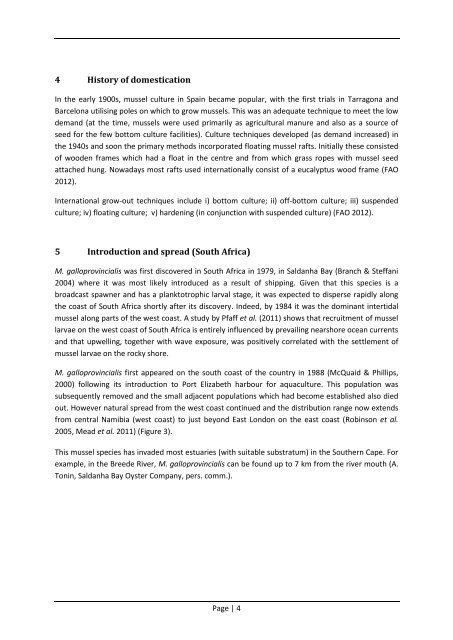Mediterranean mussel Mytilus galloprovincialis - Department of ...
Mediterranean mussel Mytilus galloprovincialis - Department of ...
Mediterranean mussel Mytilus galloprovincialis - Department of ...
You also want an ePaper? Increase the reach of your titles
YUMPU automatically turns print PDFs into web optimized ePapers that Google loves.
4 History <strong>of</strong> domesticationIn the early 1900s, <strong>mussel</strong> culture in Spain became popular, with the first trials in Tarragona andBarcelona utilising poles on which to grow <strong>mussel</strong>s. This was an adequate technique to meet the lowdemand (at the time, <strong>mussel</strong>s were used primarily as agricultural manure and also as a source <strong>of</strong>seed for the few bottom culture facilities). Culture techniques developed (as demand increased) inthe 1940s and soon the primary methods incorporated floating <strong>mussel</strong> rafts. Initially these consisted<strong>of</strong> wooden frames which had a float in the centre and from which grass ropes with <strong>mussel</strong> seedattached hung. Nowadays most rafts used internationally consist <strong>of</strong> a eucalyptus wood frame (FAO2012).International grow-out techniques include i) bottom culture; ii) <strong>of</strong>f-bottom culture; iii) suspendedculture; iv) floating culture; v) hardening (in conjunction with suspended culture) (FAO 2012).5 Introduction and spread (South Africa)M. <strong>galloprovincialis</strong> was first discovered in South Africa in 1979, in Saldanha Bay (Branch & Steffani2004) where it was most likely introduced as a result <strong>of</strong> shipping. Given that this species is abroadcast spawner and has a planktotrophic larval stage, it was expected to disperse rapidly alongthe coast <strong>of</strong> South Africa shortly after its discovery. Indeed, by 1984 it was the dominant intertidal<strong>mussel</strong> along parts <strong>of</strong> the west coast. A study by Pfaff et al. (2011) shows that recruitment <strong>of</strong> <strong>mussel</strong>larvae on the west coast <strong>of</strong> South Africa is entirely influenced by prevailing nearshore ocean currentsand that upwelling, together with wave exposure, was positively correlated with the settlement <strong>of</strong><strong>mussel</strong> larvae on the rocky shore.M. <strong>galloprovincialis</strong> first appeared on the south coast <strong>of</strong> the country in 1988 (McQuaid & Phillips,2000) following its introduction to Port Elizabeth harbour for aquaculture. This population wassubsequently removed and the small adjacent populations which had become established also diedout. However natural spread from the west coast continued and the distribution range now extendsfrom central Namibia (west coast) to just beyond East London on the east coast (Robinson et al.2005, Mead et al. 2011) (Figure 3).This <strong>mussel</strong> species has invaded most estuaries (with suitable substratum) in the Southern Cape. Forexample, in the Breede River, M. <strong>galloprovincialis</strong> can be found up to 7 km from the river mouth (A.Tonin, Saldanha Bay Oyster Company, pers. comm.).Page | 4
















